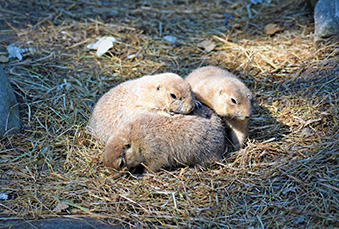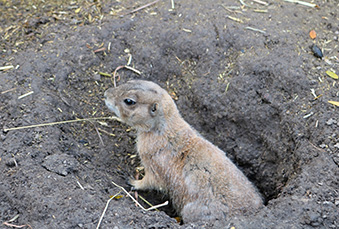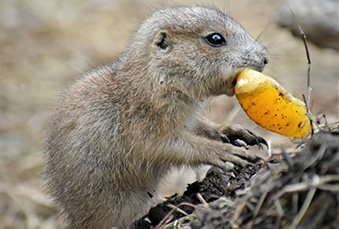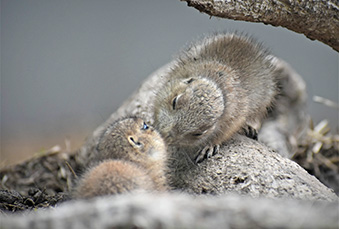Cynomys ludovicianus | Prairie dog




Meet the Prairie Dogs
Lively, social, and endlessly fascinating—our prairie dogs are tiny ecosystem engineers with big personalities! These charismatic rodents live in bustling underground towns and are known for their distinctive yip-like barks and constant activity. Despite their name, prairie dogs aren’t actually dogs at all—they’re part of the squirrel family. Their scientific name Cynomys even translates from Greek to “dog mouse”.
Whether they’re popping out of burrows, wrestling with coterie mates, or standing guard with sharp chirps and barks, prairie dogs are a fan favorite.
Life Below the Surface
Black-tailed prairie dogs are expert diggers and social animals, building complex underground networks called “towns”. These towns are divided into smaller family units known as coteries, which typically consist of one territorial male, several related females, and their young. Occasionally, a second male—often a brother—joins the group.
- Towns can include hundreds of individuals.
- The largest ever recorded spanned 65,000 square kilometers and housed 400 million prairie dogs!
- Burrows have separate chambers for sleeping, raising pups, and ventilation.
Family First
Prairie dogs exhibit sexual dimorphism—males are generally larger and heavier than females—and are polygynous, with one male with multiple female partners.
- Breeding occurs once a year.
- Litters range from 1–8 pups, but average 3 surviving young per female.
- Pups are born altricial – blind, hairless, and helpless.
- Prairie dogs are cooperative breeders, once they have moved above ground, which means that females may nurse pups that aren’t their own.
- Males usually leave their coterie after a year, while females stay for life.
Winter Adaption
Unlike true hibernators, black-tailed prairie dogs enter a state of torpor during winter.
During torpor:
- Activity and appetite decrease.
- Heart rate and body temperature do not drop significantly (unlike hibernation).
- May still be active on warmer winter days.
Because they go into torpor, instead of hibernation, our Animal Care staff provide our prairie dogs with food and water throughout the year.
Where Do They Live?
Prairie dogs are native to the central plains of North America and are typically found in:
- Short-grass prairies from central Texas to the U.S.-Canada border.
- Areas with low moisture, often where sagebrush, greasewood, and prickly pear grow.
- Flat, open landscapes ideal for spotting predators and digging tunnels.
A Prairie Full of Personality
Don’t let their size fool you—prairie dogs are full of energy and communication. They:
- Bark, chirp, and whistle to warn about predators.
- Use unique calls that can describe specific threats like hawks or coyotes.
- Play, groom, and muzzle each other as part of their social bonding.
- Are always digging, wrestling, or keeping lookout—never a dull moment!
Fact Sheet
Taxonomy
Genus: Cynomys | Species: ludovicianus |
Kingdom: Animalia | Phylum: Chordata | Class: Mammalia | Order: Rodentia | Family: Sciuridae |
Favorite Enrichment Type
Newspaper to shred, bamboo browse, cardboard boxes to gnaw on, and big food dishes to sit in while they eat.
What We Sound Like
Life Span
- In the Wild: Average of 1 year, with a high for males at 5 years and a high for females at 8 years.
- In Human Care: 8+ years.
Diet
- In the Wild: Grasses, weeds, and forbs, specifically the leaves stems and roots. Every so often, they also consume grasshoppers, cut-worms, bugs, and beetles.
- At the Zoo: High-fiber alfalfa cubes, yams, carrots, and hay.
Geographic Range
Great Plains east of the Rocky Mountains from Saskatchewan to Sonora and Chihuahua in Mexico.
Habitat
Prairie dogs inhabit short-grass plains that are generally open, level ground, and arid. Often being found where sagebrush, greasewood, and prickly pear grow, in areas of very low moisture.
Status: Least Concern
Breeding and Conservation
While listed as Least Concern, black-tailed prairie dogs have lost much of their historic range due to habitat destruction, poisoning, and extermination efforts from ranching interests.
They are a keystone species, meaning their presence supports many other species:
- Major prey for predators like the endangered black-footed ferret.
- Burrows provide shelter for other animals.
- Their digging aerates soil and promotes healthy vegetation.
Protecting prairie dogs means protecting an entire ecosystem.
How to Find Us
Visit our prairie dog habitat across from the Fossil Find, kitty-corner from the American Alligator habitat. Take some time to watch them pop in and out of their burrows, bark warnings, or engage in playful tussles. Just remember—if they “yip” at you, you’ve been noticed!
